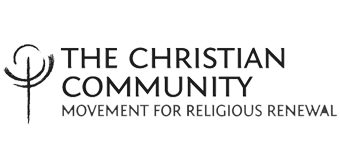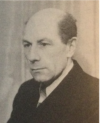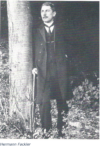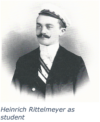Wilhelm Alexander Ruhtenberg
Die Gruender der Christengemeinschaft: Ein Schicksalsnetz
By Rudolf F. Gaedeke
Translated by Cindy Hindes
Wilhelm Ruhtenberg – January 17, 1888, Riga – August 31, 1954, Bensberg
Wilhelm Ruhtenberg was born in Riga on January 17, 1888, the fourth of six children. His father ran a large cigarette factory in the former Hanseatic city with worldwide trade relations through the Russian Empire to Vladivostok. The upper-middle-class life of a Baltic family based on traditions formed the framework of the boy’s childhood. In the tenth year of his life, a serious illness forced him to a two-year sickbed. In order to spare him the ancient languages, his father sent him to a secondary school after his recovery. Throughout his life, Ruhtenberg admired his teacher there with gratitude.
Reading a biography of a minister (O. Funke, Die Fußspuren des lebendigen Gottes auf meinem Lebenswege [Footprints of the Living God on My Life Path]) ignited in him the will to become a pastor. The tradition of the merchant family and the unsuitable school education without ancient languages initially stood in the way. But his father allowed him to take private lessons in Latin and Greek so that a special examination would allow him to graduate from secondary school and study theology.
Ruhtenberg studied at the University of Dorpat from the autumn of 1907 until his academic exams with Adolf von Harnack in the autumn of 1914. He spent one semester each in Berlin and Leipzig. His disappointment with the study of theology and its then-common textual criticism of the Bible was so deep that acting as a preacher of the Gospel and pastor was out of the question.
His time in Dorpat, however, brought him a meeting with Nora Umblia, who was born and raised there. Their marriage, celebrated in 1913, brought two children. Without later remembering personally, he also met the student Herbert Hahn in Dorpat.
The First World War isolated the young family in Riga. They had to refrain from traveling abroad or studying. Ruhtenberg became a teacher at a private high school in Riga in 1914, and at the end of 1915, pastor-adjunct at St. Gertrude’s Church until 1917. While he was devoting his time primarily with private philosophical studies, the end of the war came and then that most terrible, inhuman time.
After the serious illness that he had survived in childhood, he now came even closer to death from hunger and months of mortal danger during the occupation. His wife managed to escape with the children. He himself was initially hired under the Bolsheviks as an elementary school lecturer. He had become acquainted with Rudolf Steiner’s writings at a bookseller’s in Riga and had an enduring enthusiasm for Steiner’s Riddles of Philosophy. This presentation rekindled in him a confidence in thinking and thus in the spirit. His audience grew when he treated the ancient Greek thinkers (pre-Socratics) with this background.
But because he was a pastor, he was suddenly taken to Dünaburg with a penal battalion condemned to death. He survived this time probably only because he had previously trained his body, weakened by hunger, to good performance through much sport. Now, with the help of Jews, and disguised as a Jew, he was able to escape by ship across the Baltic Sea to Lübeck (1919). Behind him, in the east, a world was lost.
He then had the inner certainty that he would have to move to Stuttgart. There the future would show itself; above all, he would meet Rudolf Steiner. So he went to Stuttgart, met his wife and children again and heard a public lecture by Rudolf Steiner for the first time. Soon he became a member of the Anthroposophical Society. Then followed the great years of intensive double activity. First, Rudolf Steiner soon accepted him as a class teacher in the Waldorf School (January 1921). He was exactly 33 years old when this request, which he had made, was granted.
The family lived – always with a few boarding students – in a small wooden house on the school grounds on Uhlandshöhe. A small fortune had been lost to him in the collapse of Futurum A.G. in Switzerland. ( Futurum A.G. was an “Economic Society for the International Promotion of Economic and Spiritual Values”, i.e. a bank-like institute, with headquarters in Dornach existing from 1920 to 1924.)
Before being hired as a teacher, Wilhelm Ruhtenberg had asked Rudolf Steiner if he should take over an offered pastorate. Rudolf Steiner wanted only to answer the question in the affirmative if it would be possible to preach from the pulpit about repeated earth lives—only then would it make sense.
 In addition to his work as a classroom teacher, he was soon appointed as a teacher of independent Christian religious education with the task of holding Sunday services as well. His religious groups had over sixty children! During the same period, people repeatedly turned to him – or were sent to him by Rudolf Steiner –requesting baptisms or marriages.
In addition to his work as a classroom teacher, he was soon appointed as a teacher of independent Christian religious education with the task of holding Sunday services as well. His religious groups had over sixty children! During the same period, people repeatedly turned to him – or were sent to him by Rudolf Steiner –requesting baptisms or marriages.
So it happened that he asked Rudolf Steiner for a baptismal ritual and a wedding ritual and received them – with the details for the vestments and other elements of the ceremony. In this way, shortly before the actual founding of The Christian Community, when the nascent circle of priests was just forming, there were six baptisms and one wedding with the same wording as was then handed over to The Christian Community. The rituals were given to Ruhtenberg as an ordained pastor, because he had official authorization to perfom baptisms and weddings.
Then the time came for the immediate founding of The Christian Community. Ruhtenberg took part in all the preparatory courses from the beginning and was ordained a priest in Dornach on September 16, 1922, as the fourteenth member of Emil Bock’s circle. Although he was now also a priest, he continued to work as a teacher at the Waldorf School in Stuttgart until 1930. Then he worked – after a second marriage – from 1933 in the congregations of Rostock, Leipzig and especially Chemnitz until the ban of The Christian Community in 1941. After the ban and the end of the war, which Wilhelm Ruhtenberg survived in the ‘army post billing center’ in Chemnitz, there was strangely no more permanent parish work. After his escape, we find Wilhelm Ruhtenberg with friends in Überlingen working as a curative teacher in Holstein and finally in Bensberg near Cologne, where he died on August 31, 1954.
His path had led him from east to west. Then came the line added from south to north. His special mission was to be a special link between the school movement and The Christian Community, which he entirely fulfilled in the middle of his life. He embodied a very unique combination of an aristocratic, cosmopolitan attitude of body and mind with a tender ‘eastern’ soul. As a result, he was extraordinarily sensitive and vulnerable. This is how his friend and colleague Herbert Hahn described him from the founding years of the Waldorf School. This tender soul was also evident in his fine translations of the poetry of the Russian Alexander Remisow. (Further details of his biography can be read in Der Lehrerkreis um Rudolf Steiner in der ersten Waldorfschule 1919-1925, 2nd ed. Stuttgart 1978, p. 205ff.)

 Hermann Fackler, too, was already a long-serving pastor when The Christian Community was founded. At thirty-six, he belonged to the group of the older ones at that time. Nevertheless, he was still able to serve the movement for over fifty years.
Hermann Fackler, too, was already a long-serving pastor when The Christian Community was founded. At thirty-six, he belonged to the group of the older ones at that time. Nevertheless, he was still able to serve the movement for over fifty years. In the autumn of the following year (1921), he took a short holiday with his wife in nearby Waldshut that was broken off after a week due to inner turmoil. At home, a single letter was found that had not been forwarded. It was an invitation from a completely unknown Rudolf Meyer from Stuttgart to come to Dornach for the theology course which was about to begin.
In the autumn of the following year (1921), he took a short holiday with his wife in nearby Waldshut that was broken off after a week due to inner turmoil. At home, a single letter was found that had not been forwarded. It was an invitation from a completely unknown Rudolf Meyer from Stuttgart to come to Dornach for the theology course which was about to begin. In the fifties, it was possible to buy a house and build a community room in Goethean style, which still serves the community today. Beginning with the first volume of The Christian Community magazine, a wealth of essays by Hermann Fackler has appeared, reflecting the breadth of his education and interests. He also published articles in other journals and newspapers, such as Die Kommenden, Blätter für Anthroposophie, Entscheidung, Die Drei, Die Tat, and others. He also wrote poetry and painted. As a lecturer, however, he was less prominent. He worked in silence through many visits and conversations and appeared outwardly closed.
In the fifties, it was possible to buy a house and build a community room in Goethean style, which still serves the community today. Beginning with the first volume of The Christian Community magazine, a wealth of essays by Hermann Fackler has appeared, reflecting the breadth of his education and interests. He also published articles in other journals and newspapers, such as Die Kommenden, Blätter für Anthroposophie, Entscheidung, Die Drei, Die Tat, and others. He also wrote poetry and painted. As a lecturer, however, he was less prominent. He worked in silence through many visits and conversations and appeared outwardly closed.
 But the confirmand already got into difficulties because he had to profess a faith that would bind him for life. When, in the same year, his brother Friedrich, who was seven years older, traveled home from his intermediate semesters in Berlin and had conversations with the confirmand, further uncertainties arose; years of doubt followed. Yes, Heinrich Rittelmeyer felt himself to be a ‘heretic.’ But he was quite sure: “God is a reality, and the divinity of Christ is a reality because they had brought about the change in my temperament.”
But the confirmand already got into difficulties because he had to profess a faith that would bind him for life. When, in the same year, his brother Friedrich, who was seven years older, traveled home from his intermediate semesters in Berlin and had conversations with the confirmand, further uncertainties arose; years of doubt followed. Yes, Heinrich Rittelmeyer felt himself to be a ‘heretic.’ But he was quite sure: “God is a reality, and the divinity of Christ is a reality because they had brought about the change in my temperament.” mythology, he applied to the Westphalian Minister of Culture to go to the area where the memory of Germanic history was alive. His professional responsibilities in Herford became even greater.
mythology, he applied to the Westphalian Minister of Culture to go to the area where the memory of Germanic history was alive. His professional responsibilities in Herford became even greater.